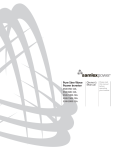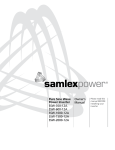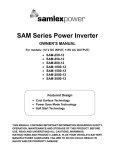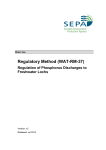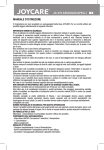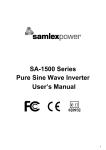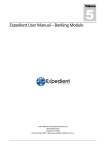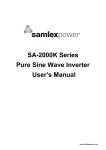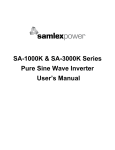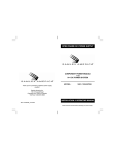Download Samlexpower SSW-600-12A Owner`s manual
Transcript
Pure Sine Wave Power Inverter SSW-350-12A SSW-600-12A SSW-1000-12A SSW-1500-12A SSW-2000-12A Owner's Manual Please read this manual before operating your inverter INDEX 1. Important Safety Instructions............................. 3 2. How Your Inverter Works................................... 5 3. Installation / Environments................................. 6 4. Operating Tips..................................................... 10 5. Protective Features of the Inverter.................... 12 6. Special Features................................................... 13 7. Troubleshooting Guide....................................... 14 8. Fuse Replacement............................................... 16 9. Specifications....................................................... 17 10. Warranty.............................................................. 18 2 1 IMPORTANT SAFETY INSTRUCTIONS THIS MANUAL CONTAINS IMPORTANT INFORMATION REGARDING SAFETY, OPERATION, MAINTENANCE AND STORAGE OF THIS PRODUCT. BEFORE USE, READ AND UNDERSTAND ALL CAUTIONS, WARNINGS, INSTRUCTIONS AND PRODUCT LABELS, PLUS YOUR VEHICLE’S BATTERY MANUFACTURER GUIDELINES. FAILURE TO DO SO COULD RESULT IN INJURY AND/OR PROPERTY DAMAGE. To ensure reliable service, your power inverter must be installed and used properly. Please read the installation and operating instructions thoroughly prior to installation and use. Pay particular attention to the WARNING and CAUTION statements in this manual. The CAUTION statements advise against certain conditions and practices that may result in damage to your inverter. The WARNING statements identify conditions or practices that may result in personal injury. Read All Instructions Before Using This Power Inverter! WARNINGS TO REDUCE THE RISK OF FIRE, ELECTRIC SHOCK, EXPLOSION OR INJURY 1. Do not connect to AC distribution wiring. This inverter is NOT grid interactive. 2. Remove appliance plug from outlet strip or turn off inverter before working on the appliance. Multiple outlet power strips with switches and circuit breakers only interrupt power to the “hot” receptacle terminals. For SSW-350-12A & SSW-600-12A, the “Neutral” terminals remain powered with respect to the “Ground” terminals. 3. Do not make any electrical connections or disconnections in areas designated as IGNITION PROTECTED. This includes 12 V DC cigarette plug connections, and terminal connections. 4. This is not a toy - keep away from children. 5. DO NOT install object into air vents. CAUTIONS 1. The chassis and the input Negative terminal of the inverter are internally connected to the AC Ground. Hence, the input Negative terminal should be used as the grounding terminal. Do not use with Positive Grounded Electrical Systems (the majority of modern automobiles, RVs, trucks and boats are Negative Grounded Electrical Systems). 2. Observe correct polarity when connecting the DC input terminals of the inverter to the battery. Connect Positive of the battery to the Positive input connector of the inverter and the Negative of the battery to the Negative input terminal of the inverter. Reverse polarity connection will result in a blown fuse and may cause permanent damage to the inverter. Damage due to reverse polarity is not covered under warranty. 3. This inverter will not operate high wattage appliances that exceed the output power limit or the surge power limit. 4. For SSW-350-12A & SSW-600-12A, grounding the Neutral will cause the inverter to shut down. Hence, do not connect the Neutral of the AC output receptacles to Ground. 5. Do not operate this inverter if it is wet. 6. Do not install in engine compartment – please install in a well ventilated area. 7. This inverter is not tested for use with medical devices. 3 1 IMPORTANT SAFETY INSTRUCTIONS IMPORTANT WIRING INFORMATION Substantial power loss and reduced battery operating time results from inverters installed with wires that are not sized correctly based on the length and the current required to be carried. Current flowing through a wire produces voltage drop along its length due to the resistance of the wire and due to the value of the current carried through it. The resistance of the wire is inversely proportional to the cross-sectional area of the wire (designated in mm2 or AWG) and directly proportional to its length i.e. thinner and longer wire has higher resistance and hence, produces higher voltage drop. Similarly, thicker and shorter wire has lower resistance and hence, produces lower voltage drop. Hence, symptoms of low DC input voltage / battery power can result from wires that are either excessively long or have an insufficient cross-sectional area (designated in mm2 or AWG). The wires should be sized based on the maximum current they are required to carry and the distance between the battery and the inverter to limit the voltage drop to 2% to 5%. Wires are rated based on its insulation, temperature and operating environment. Please ensure that the wire insulation is of the appropriate type for the operating environment. The installer/operator should be especially aware of the requirements to maintain secure, tight, water-resistant electrical connections and to provide for strain relief for DC wires and appliance wiring. 4 2 HOW YOUR INVERTER WORKS The inverter converts low voltage DC (Direct Current) from a battery or other DC power source to the standard nominal 115 volt AC (Alternating Current) household power. DESIGN FEATURES • • • • • High efficiency Compact size Low Idle current Soft Start Technology LCD Remote Control (for 1000 W, 1500 W & 2000 W models). POWER RATINGS The continuous power ratings of the models are as follows: • SSW-350-12A - 350 Watts • SSW-600-12A - 600 Watts • SSW-1000-12A - 1000 Watts • SSW-1500-12A - 1500 Watts • SSW-2000-12A - 2000 Watts PRINCIPLE OF OPERATION The inverter converts power in two stages. The first stage is a DC to DC conversion process that raises the low voltage DC at the inverter input to high voltage DC of approximately 150 VDC. The second stage is the actual inverter stage that converts the high voltage DC into nominal 115 VAC, 60 Hz AC (RMS). The DC-toDC converter stage uses modern high frequency power conversion techniques that have replaced the bulky transformers found in less technologically-advanced models. The inverter stage uses advanced power MOSFET transistors in a high frequency full bridge configuration. THE OUTPUT WAVEFORM The AC output waveform of the SSW-series inverter is known as “Pure Sine Wave” or “True Sine Wave”. It is a waveform that has characteristics same to the sine wave shape of utility power (See Fig. 1). 1.0 0.5 -6 -4 -2 2 4 6 - 0.5 - 1.0 Fig.1. Pure Sine Wave Waveform 5 3 INSTALLATION / ENVIRONMENTS DC POWER SOURCE REQUIREMENTS The DC power source must provide between 10.5 and 15.5 Volts DC and must be able to supply the necessary current to operate the load. The power source may be a battery or a well-regulated DC power supply. To obtain a rough estimate of the current (in Amperes) the power source must deliver, simply divide the power consumption of the load (in Watts AC) by 10. Example: if a load is rated at 100 Watts AC, the DC power source must be able to deliver: 100 / 10 = 10A. The inverter will provide you nominal 115 VAC when powered by a 12 VDC source such as is found in a vehicle or multiple battery configurations as shown in Fig. 2. This manual does not describe all of the possible types of battery configurations, battery charging configurations and battery isolation configurations. For normal operation of the inverter, the DC power source must provide between 11.0 and 15.0 VDC and the required current. This DC power source must be a well-regulated DC power supply or alternator and deep cycle battery system typically found in vehicles and marine crafts. The DC power source may also be two or more 12 volt batteries connected in parallel. On larger applications, the power source may be several batteries connected in parallel as shown in Fig. 2. BATTERIES CHARGING FROM COMMERCIAL AC-DC, ENGINE, SOLAR, ETC. AC SIDE FUSE BATTERY DC SIDE BATTERY POWER INVERTER BATTERY Fig.2. Connecting to a DC Power Source INSTALLATION NOTES WARNING: Ensure ventilation when using batteries. Batteries may generate flammable gas during charging or discharging. The inverter (350 W to 2000 W models) has four slots in its mounting bracket that allow the unit to be fastened against a bulkhead, floor, wall or other flat surface. Ideally, the mounting surface should be cool to the touch. It is more electrically efficient to use longer AC wiring than DC wiring, so install the inverter as close as possible to the 12 VDC power source. 6 3 INSTALLATION / ENVIRONMENTS The inverter can be operated in any position, however, if it is to be mounted on a wall, mount it horizontally (Fig 3a) so that indicators, switches, outlets and terminal blocks located on the front panel are visible and accessible. Do not mount on wall in positions shown in Figs. 3 (b) & 3(c). If the inverter is to be installed in a moving vehicle, we strongly recommend that the inverter be shock-mounted either on the floor (in a clear, safe area) or on a secure flat surface (Fig 3a) (a) (b) (c) Fig. 3 Mounting arrangement on wall CAUTION The power inverter must be connected only to batteries with a nominal output voltage of 12 V. The unit will not operate from a 6 Volt battery, and will sustain permanent damage if connected to a 24 V battery. CAUTION Loose connectors may cause overheated wires and melted insulation. Check to make sure you have not reversed the polarity. Reverse polarity connection will result in a blown fuse and may cause permanent damage to the inverter. Damage due to reverse polarity is not covered by warranty. CONNECTING TO A DC POWER SOURCE Please ensure that the DC side wires and external fuses are selected as given below. Note that an external fuse is required to protect the battery wires from short circuit. A battery is an unlimited source of current and can deliver extremely high (up to 10,000 A of current) into a short circuit that will melt the wires and cause fire hazard. Current limiting fuse with Ampere Interrupting Capacity (AIC) of 10000 A or more or Class T fuse is, therefore, recommended. External FUSE and DC wire selection WATTAGE OF THE INVERTER CAPACITY OF THE FUSE 350W 600W 1000W 1500W 2000W 50A 80A 150A 200A 300A RECOMMENDED MODEL NO. OF FUSE ASSEMBLY MANUFACTURED BY SAMLEX AMERICA, INC. DC-FA-200 DC-FA-300 WIRE SIZE (AWG) MAX DISTANCE BETWEEN INVERTER AND THE BATTERY #8 #6 #4 #2 2 X #2 1.5M 1.5M 1.2M 1.2M 1.0M 7 3 INSTALLATION / ENVIRONMENTS CONNECTING WIRES FOR BATTERY INPUT POWER - SSW-350-12A & SSW-600-12A For convenience of providing DC input power from the battery, the 350 W Model No. SSW-350-12A and the 600 W Model No. SSW-600-12A are provided with the following DC connecting wires: • SSW-600-12A - 3 ft. long pair of Positive and Negative wires with battery clamps • SSW-350-12A - 3 ft. long pair of Positive and Negative wires with battery clamps When using these wires, please ensure that appropriate DC fuses are used as recommended in the Table on page 7. CONNECTING WIRES FOR BATTERY INPUT POWER – SSW-1000-12A, SSW-1500-12A & SSW-2000-12A DC side connecting wires have not been provided for these inverters and these have to be arranged by the end user. Please use the appropriate sizes of wires and fuses as per recommendations provided in the Table given on page 7. Crimp / solder appropriate ring type of lugs on the wire ends that connect to the DC side input terminals to suit the size of the wire and the M9 stud. DC SIDE INPUT TERMINALS The following DC side input terminals have been provided: • SSW-350-12A & SSW-600-12A • SSW-1000-12A, SSW-1500-12A, SSW-200-12A - Thumb screw – size M4 - Stud and nut – size M9 MAKING DC SIDE CONNECTIONS 1. Ensure that appropriate terminal lugs are used and are properly crimped / soldered at the bare ends of the wires for secure connections. 2. Ensure that the inverter’s power switch is turned off and that no flammable fumes are present. 3. Identify the Positive (+) and Negative (-) terminals of the 12 V battery or other DC source. 4. Install a fuse holder or breaker close to the Positive (+) terminal of the battery (or other DC source) (preferably within 7” of the terminal) . 5. Cut an appropriate short piece of the selected Positive wire and use this to piece to connect the Positive terminal of the battery (or other DC source) to one terminal of the fuse holder or breaker. Connect one end of the remaining length of wire to the other terminal of the fuse holder or breaker. Connect the other end of the wire to the Positive terminal of the inverter. 6. Connect the selected length of Negative wire between the Negative terminal of the battery (or other DC source) and the Negative (-) terminal of the inverter. 7. Insert a suitable fuse in the fuse holder. 8. Check to be sure that all connections are secure and tight. 9. Test the inverter by turning it on and plugging in a 100 Watt lamp or equipment. 10. If the inverter is not properly operating, then refer to the Troubleshooting Guide at page 14 of this manual. CAUTION: Loose connectors may cause overheated wires and melted insulation. SWITCHING ON AND SWITCHING OFF ON LOAD Please ensure that the following procedure is used for switching on and switching off the inverter when a load is already connected to the inverter: 8 3 INSTALLATION / ENVIRONMENTS Switching on 1. 2. 3. 4. Switch off the load connected to the inverter Switch on the inverter Wait for a few seconds Switch on the load Switching off 1. Switch off the load connected to the inverter 2. Switch off the inverter CONNECTING LOADS 1. Make sure that the single load or the combined load requirement of your equipment does not exceed the inverter’s output rating. 2. Switch off the inverter 3. Switch off the load 4. Plug the cord(s) from the load(s) into the AC receptacle(s) of the inverter 5. Switch on the inverter. Wait for a few seconds 6. The green LED indicator will be lighted to indicate that the inverter is functioning 7. Switch on the load(s) The inverter is engineered to be connected directly to standard electrical and electronic equipment in the manner described above. Do not connect the power inverter to household or RV AC distribution wiring. Do not connect the power inverter to any AC load circuit in which the Neutral conductor is connected to Ground (Earth) or to the Negative of the DC (battery) source. WARNING: Do not connect directly to AC distribution wiring. This inverter is NOT grid interactive. OPERATING ENVIRONMENT For best operating results, the inverter should be placed on flat surface, such as the ground, car floor, or other solid surface. The power cord allows easy positioning of the inverter. The inverter should only be used in locations that meet the following criteria: DRY Do not allow water and/or other liquids to come into contact with the power inverter. In all marine applications, do not install the inverter below or near the waterline and keep the inverter away from moisture or water. COOL Ambient air temperature should be between 30 degrees F (-1 degree C) non-condensing, and 105 degrees F (40 degrees C). Do not place the inverter on or near a heating vent or any piece of equipment which is generating heat above room temperature. Keep the inverter away from direct sunlight, if at all possible. VENTILATED The unit is cooled by load controlled fan (s). The fan(s) will be normally switched off at low loads to conserve battery power and will be switched on automatically once the load reaches a certain threshold. Keep the area surrounding the inverter clear to ensure free air circulation around the unit. Do not place items on or over the inverter during operation. An additional external fan is helpful if the inverter is operating at maximum power outputs for extended periods of time. The unit will shut down if the internal temperature exceeds the operating temperatures. The unit will restart after it cools. SAFE Do not use the inverter near flammable materials or in any locations that may accumulate flammable fumes of gases. 9 4 OPERATING TIPS RATED VERSUS ACTUAL CURRENT DRAW OF EQUIPMENT Most electrical tools, appliances and audio/video equipment have labels that indicate the power consumption in Amps or Watts. Be sure that the power consumption of the item you wish to operate is less than inverter’s power. (If the power consumption is rated in Amps AC, simply multiply by the AC Volts (115) to determine the approximate Wattage). The inverter will shut down if it is overloaded. The overload must be removed before the inverter will restart. Resistive loads are the easiest for the inverter to run. However, larger resistive loads, such as electric stoves or heaters, usually require more wattage than the inverter can deliver. Inductive loads, such as TV’s and stereos, require more current to operate than do resistive loads of the same wattage rating. Induction motors, as well as some televisions, may require 2 to 6 times their wattage rating to start up. The most demanding in this category are those that start under load, such as compressors and pumps. To restart the unit after a shutdown due to overloading, remove the overload if necessary turn the power switch OFF, wait for at least 3 minutes and then switch ON again. SIZING CHART FOR TYPICAL LOADS THAT REQUIRE HIGH STARTING SURGE The manufacturers’ specifications of the appliances and devices indicate only the running power required. The surge power required by some specific types of devices has to be checked with the manufacturer, actually tested or guessed at best. The Table below lists some common loads that require high surge power on start up. A “Sizing Factor” has been recommended against each which is a Multiplication Factor to be applied to the rated running Watt rating of the load to arrive at the continuous power rating of the inverter (Multiply the running Watts of the device / appliance by the Sizing Factor). TYPE OF DEVICE OR APPLIANCE SIZING FACTOR Air conditioner 5 Refrigerator / Freezer (Compressor based) 5 Air Compressor 4 Sump Pump / Well Pump / Submersible Pump 3 Dishwasher 3 Clothes Washer 3 Microwave (In cases where the rated output power is the cooking power) 2 Furnace Fan 3 Industrial Motor 3 Portable Kerosene / Diesel Fuel Heater 3 Circular Saw 3 Bench Grinder 3 Incandescent / Halogen / Quartz Lamps 3 Laser Printer / Other Devices using Quartz Lamps for heating 3 Switched Mode Power Supplies 3 Photographic Strobe / Flash Lights (with respect to its Watt Sec rating) 4* * In the case of photographic strobe / flash unit, the RMS surge power of the inverter should be more than 4 times the Watt Sec rating of the unit. 10 4 OPERATING TIPS DETERMINING BATTERY SIZE The power inverter will require DEEP CYCLE lead acid batteries of appropriate capacity. The automotive SLI (Starting/lighting/Ignition) battery is not designed for repeated deep discharge. The SLI battery may not supply enough energy and its service life may be reduced. To determine the minimum battery size that you will need to operate appliances, follow these steps: 1. Determine the AC wattage of each appliance and / or tool you will need to simultaneously operate from the inverter. To do this, read the labels on the equipment to be operated. Usually, power consumption is shown in Watts. If it is shown in Amps, multiply by 115 to determine the AC wattage. 2. For each appliance, estimate the number of hours the appliance will be in use between battery recharges. 3. For each appliance, determine the Watt-Hours of energy required by multiplying the AC wattage by the number of hours of use. 4. Add the Watt-Hours of energy for each appliance to get the total Watt-Hours of energy for all appliances to be used. 5. Divide the total Watt-Hours of energy on the AC side by 10 to get the total Ampere-Hour of energy on the 12 VDC side to support the operation of the appliances. 6. The Ampere-Hour (AH) capacity of the battery should be 2 times the total Ampere-Hour energy required on the 12 VDC side to support the operation of the devices (as calculated at step 5 above). Two times factor is necessary because batteries are normally not discharged below 50% capacity. To get an estimate of the current (in Amps) that the battery is delivering, divide the load's AC consumption power (in Watts) by (10). Keep in mind that most appliances are not operating for long periods of time. For example, a typical homeuse coffee maker draws 500 Watts during its brew time of 5 minutes, but it maintains the temperature of the pot at about 100 Watts. Typical use of a microwave is only for a few minutes, sometimes at low power. Some exceptions to brief operating times are TVs, computers etc. In most instances, the inverter can be left connected to the battery when not in use, make sure power switch is in the OFF position. Battery performance drops in low temperature environment. Higher capacity batteries should be installed if the environmental temperature is below 20oC. 11 5 PROTECTIVE FEATURES OF THE INVERTER OVER TEMPERATURE PROTECTION The unit is cooled by load controlled fan (s). The fan(s) will be normally switched off at low loads to conserve battery power and will be switched on automatically once the load reaches a certain threshold. In case the fan fails or if the cooling is inadequate due to higher ambient temperature or restricted air flow, the temperature inside the inverter will be too high and the unit will automatically shut down. Allow the unit to cool for at least 15 minutes before restarting after a heat-related shutdown. Unplug unit while cooling. LOW BATTERY VOLTAGE PROTECTION This condition is not harmful to the inverter but could damage the power source. The inverter automatically shuts down when input voltage drops to 10.5 Volts. OVER VOLTAGE PROTECTION The inverter will automatically shut down when the input voltage exceeds 15.3 Volts DC. Input voltage exceeding 16 Volts could damage the inverter. OVERLOAD PROTECTION The inverter will automatically shut down when the continuous draw exceeds rated Watts. SHORT CIRCUIT PROTECTION The inverter will shut down. Remove the short circuit and restart inverter. EARTH FAULT PROTECTION This inverter complies with the standard current leakage allowance. When large current leakage to earth terminal occurs, the protection circuit activates and shuts down the inverter, which prevents electric shock to humans. Turn OFF the inverter, unplug the fault AC appliance and then turn ON is the only way to restart it. The 1000, 1500 and 2000 W models are provided with a GFCI that will trip in case of any leakage on the load side. The GFCI will be required to be reset LOW INPUT VOLTAGE ALARM An alarm will sound when the voltage at the input terminals of the inverter drops to 11.0 Volts. This is an indication that either the battery terminal voltage has dropped due to its discharged condition and needs to be re-charged OR there is an excessive voltage drop across the wires connecting the inverter to the battery (due to use of thinner and longer length of wires that will produce higher voltage drop at higher loads OR due to loose connections). The user should stop operation of the electronic device at this time since the inverter will shut down automatically shortly thereafter, when the input voltage at the inverter further drops to 10.5 Volts. In case the alarm is due to the discharged condition of the battery, start your engine to recharge the battery / use an appropriate battery charger. If the low voltage alarm sounds when the battery is fully charged, follow the steps for solving lack of output power in the Troubleshooting Guide at page 14. NOTE: It is normal for the alarm to sound while the unit is being connected to or disconnected from the power source. This is not indicative of a problem. 12 6 SPECIAL FEATURES USB PORT (1) REMOTE CONTROL PORT (2) OUTPUT GFCI OUTLET DC TERMINAL COVER (3) LOAD CONTROLLED FAN 350W YES NO NO NO YES 600W YES NO NO NO YES 1000W NO YES YES YES YES 1500W NO YES YES YES YES 2000W NO YES YES YES YES (1) Standard USB charging port +5 VDC, 500mA (2) Compatible with specific SAMLEX SSW-series remote control only. Connection with incompatible remote / wire will damage the power inverter / remote. (3) DC Terminal Plastic Covers and Nuts are for terminal protection only, not for wire connection. 13 7 TROUBLESHOOTING GUIDE Table. INVERTER POWER SWITCH TURNED ON TROUBLE/ INDICATION No AC output: --Yellow LED is lit --Red and Green LEDs are not lit --No audible alarm is sounded POSSIBLE CAUSE Inverter has overheated and thermal shutdown has been activated SUGGESTED REMEDY Remove or reduce the load and wait for the inverter to cool down. The inverter will be latched in shut down conditions and will require manual reset once it has cooled down sufficiently. To reset, switch off, wait for 3 min. and switch on again. No AC output: --Red, Yellow & Green LEDs are not lit --No audible alarm Non-continuous AC output: --Red LED is lit on & off --Green LED is lit on & off --Yellow LED is not lit --No audible alarm No AC output (latch up): --Red LED is lit --Yellow and Green LEDs are not lit --No audible alarm No AC output (For SSW-1000, 1500 and 2000 with GFCI) --Small green LED mounted on the GFCI outlet is not lit --Green LED on the inverter is lit --Red and Yellow LEDs are not lit --No audible alarm 14 DC side wires are loose OR external DC side fuse has opened OR the Inverter’s internal DC side fuses have open Check DC side wire connection and fuses OR contact technical support Inverter output power limited by overload / surge circuit protection circuit Reduce load. Inverter has shut down due to overload Reduce the load or disconnect the load that causes overloading. In Models SSW-350 and SSW-600 this shut down could also be due to ground fault on the load side (These models have built in Ground Fault Protection Circuit). In case of SSW-350 / SSW-600, also check for Ground fault on the load side AC output side of the GFCI protected outlet has been mechanically disconnected from its AC input side due to leakage / Ground fault on the load side (in this case, the inverter does not shut down and AC power is still available on the input side of the GFCI) Remove the Ground faulted AC load and mechanically reset the GFCI using the Reset Button provided on the GFCI When the inverter shuts down due to overload / ground fault (in case of SSW-350 / SSW-600), it will be latched in the shutdown condition and will require a manual reset. Switch off the inverter. Wait for 3 min for the internal latching circuit to de-energize and then switch on again 7 TROUBLESHOOTING GUIDE AC output is available. Audible alarm sounds intermittently when delivering high power loads DC input wire size is not adequate for higher loads OR there is loose connection between the battery and the inverter leading to low DC input voltage alarm Use thicker wire and tighten all DC input circuit connections --Green LED is lit --Yellow LED is lit --Red LED is not lit --Audible alarm is sounded Inverter has shut down due to low DC input voltage as a result of either low battery terminal voltage OR due to excessive voltage drop due to thinner wires or loose connections in the DC input circuit Recharge the battery. Use thicker DC input wires and tighten all DC input circuit connections AC output is available. Audible alarm sounds even at low loads Low DC input voltage due to low battery terminal voltage Battery is discharged – Recharge the battery. --Green LED is lit --Red LED is not lit --Yellow LED is lit when audible alarm sounds No AC output: --Red and Yellow LED are not lit --Green LED is lit Battery does not charge or it shows proper terminal voltage on no load but the voltage drops on load – Replace the battery Motorized power tool won’t start Excessive start-up load If appliance does not start, then appliance is drawing excessive wattage and will not work with inverter Motorized power tool does not operate at correct speed Purely inductive load Make the load not purely inductive. Operate an incandescent lamp at same time as motor 15 8 FUSE REPLACEMENT FUSES INSIDE THE INVERTER The AC side of this inverter is protected by an integral electronic overload circuit and will automatically reset in some cases. More than that, this inverter is equipped with a DC side fuses that are located inside the inverter. Normally, these fuses will not blow unless a serious problem occurs. Please DO NOT replace the fuses yourself. We recommend you contact technician to find and fix the problems. High voltage and high temperature inside! CAUTION: NO USER-SERVICEABLE COMPONENTS INSIDE. DO NOT ATTEMPT TO OPEN THE INVERTER. 16 9 SPECIFICATIONS Model No. SSW-350-12A SSW-600-12A DC INPUT VOLTAGE RANGE INPUT DC INPUT CURRENT at rated LOAD DC INPUT CURRENT AT NO LOAD 56 A 90 A 140 A 188 A <0.5 A <0.5 A <0.6 A <0.75 A <0.9 A 115 VAC (±5 VAC) 60 Hz (± 1Hz) AC OUTPUT WAVE FORM PROTECTIONS PURE SINE WAVE 350 W 600 W 1000 W 1500 W 2000 W 700 W 1200 W 2000 W 3000 W 4000 W PEAK EFFICIENCY 89% 89% 89% 90% 90% USB CHARGING PORT (+5VDC, 500MA) YES YES NO NO NO REMOTE CONTROL PORT (8 POSITION MODULAR CONNECTOR) NO NO YES YES YES MAXIMUM ACTIVE SURGE POWER PORTS LOW INPUT VOLTAGE WARNING ALARM 11.0 VDC LOW INPUT VOLTAGE SHUTDOWN 10.5 VDC HIGH INPUT VOLTAGE SHUTDOWN 15.3 VDC OVERLOAD SHUTDOWN YES COOLING (LOAD CONTROLLED FAN) YES INPUT TERMINALS WITH THUMB SCREW (M4) CONNECTIONS SAFETY OUTPUT NUT AND BOLT (M9) 2 x NEMA5-15 NORTH AMERICAN RECEPTACLES EMI/EMC COMPLIANCE DUAL NEMA5-20 NORTH AMERICAN RECEPTACLES WITH GFCI ETL LISTED TO UL STANDARD UL-458 OPERATING AMBIENT TEMPERATURE 0°C to 40°C; 32°F to 104°F STORAGE TEMPERATURE GENERAL SSW-2000-12A 33 A AC OUTPUT FREQUENCY CONTINUOUS ACTIVE OUTPUT POWER SSW-1500-12A 10.5 - 15.3 VDC (±0.3 VDC) AC OUTPUT VOLTAGE OUTPUT SSW-1000-12A -30°C to 70°C; -26°F to 158°F DIMENSIONS, MM (L X W X H) 7.87 X 6.10 X 2.24 9.06 X 6.10 X 2.24 10.43 X 8.74 X 3.46 12.2 X 8.74 X 3.46 12.2 X 8.74 X 3.46 DIMENSIONS, INCHES (L X W X H) 200 X 155 X 57 230 X 155 X 57 265 X 222 X 88 310 X 222 X 88 310 X 222 X 88 WEIGHT, KG 0.7 0.9 2.6 3.2 3.8 WEIGHT, LB 1.5 2 5.7 7.1 8.4 17 10 Warranty 2 YEAR Limited Warranty The Samlex SSW Series Inverters manufactured by Samlex America, Inc. (the “Warrantor“) are warranted to be free from defects in workmanship and materials under normal use and service. This warranty is in effect from the date of purchase by the user (the “Purchaser“). For a warranty claim, the Purchaser should contact the place of purchase to obtain a Return Authorization Number. The defective part or unit should be returned at the Purchaser’s expense to the authorized location. A written statement describing the nature of the defect, the date of purchase, the place of purchase, and the Purchaser’s name, address and telephone number should also be included. If upon the Warrantor’s examination, the defect proves to be the result of defective material or workmanship, the equipment will be repaired or replaced at the Warrantor’s option without charge, and returned to the Purchaser at the Warrantor’s expense. No refund of the purchase price will be granted to the Purchaser, unless the Warrantor is unable to remedy the defect after having a reasonable number of opportunities to do so. Warranty service shall be performed only by the Warrantor. Any attempt to remedy the defect by anyone other than the Warrantor shall render this warranty void. There shall be no warranty for defects or damages caused by faulty installation or hook-up, abuse or misuse of the equipment including exposure to excessive heat, salt or fresh water spray, or water immersion. No other express warranty is hereby given and there are no warranties which extend beyond those described herein. This warranty is expressly in lieu of any other expressed or implied warranties, including any implied warranty of merchantability, fitness for the ordinary purposes for which such goods are used, or fitness for a particular purpose, or any other obligations on the part of the Warrantor or its employees and representatives. DISCLAIMER OF LIABILITY There shall be no responsibility or liability whatsoever on the part of the Warrantor or its employees and representatives for injury to any persons, or damage to person or persons, or damage to property, or loss of income or profit, or any other consequential or resulting damage which may be claimed to have been incurred through the use or sale of the equipment, including any possible failure of malfunction of the equipment, or part thereof. The Warrantor assumes no liability for incidental or consequential damages of any kind. Samlex America Inc. (the “Warrantor”) 110-17 Fawcett Road Coquitlam, BC, V3K 6V2 Canada 604.525.3836 18 110-17 Fawcett Rd T: 604.525.3836 Coquitlam, BC F: 604.525.5221 Canada V3K 6V2 1.800.561.5885 SSW_Series_Inverters_Manual_Dec2010_1.0.1 e-mail: [email protected] website: www.samlexamerica.com



















